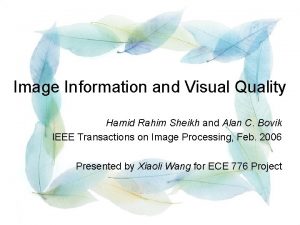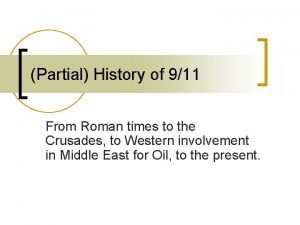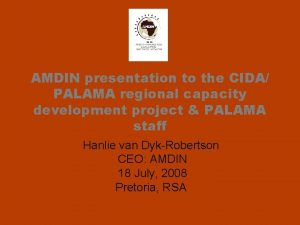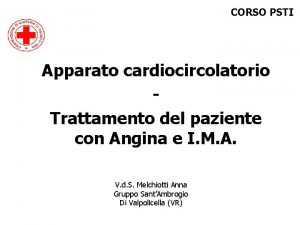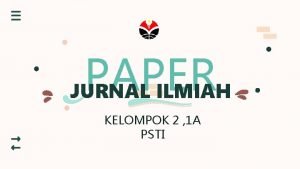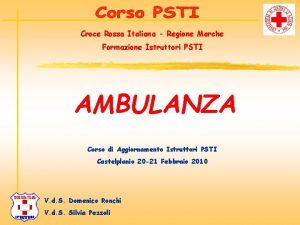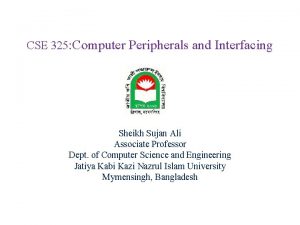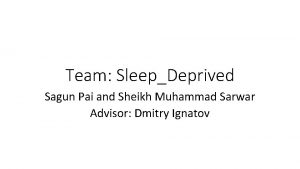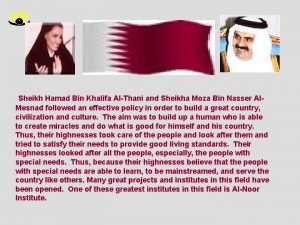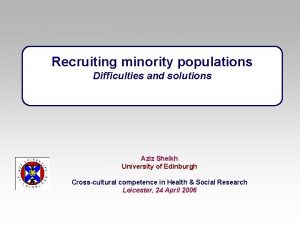AMDIN and the CAPAM PSTI network Prof Sheikh






















- Slides: 22

AMDIN and the CAPAM PSTI network Prof Sheikh A. Abdullah Chairperson: AMDIN

Who and what is AMDIN?

What is AMDIN? • A network of African Management Development Institutes (MDIs) as well as Schools and Institutes of Public Administration and Management (SIAs) and research institutes in the area of public administration/ public management/ public governance and related areas • Pan African network covering all five regions of Africa, straddling Anglophone, Francophone, Lusophone and Arabic speaking Africa • Organically linked to the AGPAP, the African Governance and Public Administration Programme, the initiative of the All Africa Conference of Ministers for Public/Civil Service, the African Union and NEPAD • Founded in 2005 and legally registered as a Non-Profit Organisation with its Secretariat based in South Africa since 2007 • Membership exclusively institutional – no individuals or governments

AMDIN’s expanding footprint 2005 2009

AMDIN Points of Departure • African ownership • Recognition and utilisation of strengths and expertise in African MDIs • Sharing knowledge and resources within the network to strengthen and empower all of the African MDIs • Collaboration and cooperation: within the network and across other networks and organisations

AMDIN Vision For MDIs to be centers of excellence capable of responding to African development challenges and global engagements AMDIN Mission To create for African MDIs a platform that articulates their collective voice and that promotes mutual partnership and collaboration with a view to developing leadership and management capacity in response to the needs of the African people and their governments

AMDIN’s role • AMDIN is positioned as Capacity Builder of those charged with Capacity Development of African public sector organisations and their employees • AMDIN is dedicated to improving the environment in which African MDIs function as well as strengthening capacity of member institutions – be that organisationally or individually

Mandate: 1 st AMDIN Biennial Conference August, 2007 AMDIN has a critical role to play in addressing the deficiencies that exists in the African MDIs – on institutional, organisational and individual levels. With the assistance of AMDIN and within a networked and constructive collective spirit, African MDIs will set out to achieve a multifaceted and durable agenda to raise their own standards and set continent-wide benchmarks to guide a process of continuous improvement.

Strategic & Operational Plan 2009 - 2011 6 Focal Areas: 1. 2. 3. 4. 5. 6. Strengthened organisational and human resource capacity for MDIs Shared African curricula and standards frameworks for continual performance improvement Knowledge relevant to the development of African public sector capacity more readily available Opportunities for networking, knowledge exchange and resource sharing increased Contribution of MDIs to African Public Sector Capacity Development extended beyond training to include other HRD approaches, research, consultancy and policy advice Enabling AMDIN Institutional Capacity

Developmental Goal Contribute to the development of Africa by strengthening democracy, good governance and public administration Purpose Empowered African MDIs effectively fulfill their developmental roles and mandate through knowledge exchange and networking

Activities in 2009 -2011 Plan • Formulated in response to extensive consultation & needs identification process in 2008 • Aimed at 6 different target groups: Heads of Institutions; Institutional Management; Training Administrators; Training and Curriculum Design Experts; Consultants; Researchers • Content wise focuses on 11 curriculum areas identified by NEPAD in the AGPAP (as adjusted over time) • Standard raising and quality improvement • African context & implications for what MDI are doing & how they are doing it

Intersection: Target Groups and Activities Target groups Heads of Institutional Managers Training Managers & Administrators Trainers & Design experts Knowledge management; Collaboration & Peer learning Individual Capacity Development/ Training Annual Heads of Institutions Forum • Change management exposure visits Problem solving “fish bowls” and “showcasing” innovative solutions • Support programme for new Heads of Institutions Placement & exchange Exposure visits/ study trips Standards of Excellence for self & peer evaluation Peer to peer learning Placement & exchange Communities of Practice in curriculum areas Peer to peer learning for professional groupings Collaborative curriculum development Awards programmes Consultants & Advisors Peer to peer learning Facilitate consortium formation & collaborative bidding On-line toolbox and example practices Researchers Collaborative research groups Make accessible on-line resource centres and info rich Dbases Joint, comparative research programmes Training CFOs/ Financial directors for resource mobilisation Build M&E capacity, with specific emphasis on RIO and Impact Assessment methodologies • Customised training course re managing e/ on-line training PLUS managing logistics for residential courses Training of Trainers – generic & subject specialisation, e. g. e-government Training Curriculum Design & Materials Development Experts (Incl. Wiki-educators) Consultancy competency development through short courses & reflective practice Placements in consulting firms Research methods & skills Introduction to technological support & software for researchers

Communities of Practice: Curriculum Development Curriculum areas Trainers Curriculum Designers & Materials Developers Researchers and subject experts Representativ es from user/ client communities E-Government and Knowledge Management Strategic Planning and Budgeting Leadership and Human Resource Development Public Sector Restructuring and HRM Inter and Intra. Governmental Relations Public Policy Development and Management Further curriculum areas: • Public Finance, Budgeting and Financial Management • Ethics and Anti-Corruption • Public Participation and Service Delivery • Globalisation and Regional Integration

What is AMDIN’s historical connection with the CAPAM PSTI?

Ghana conference • Was extensively consulted re programme, participants & AMDIN participated in programme, but AMDIN not recognised as formal partner of the event notwithstanding discussions re this • AMDIN cautioned around the special situation re existing networks, specifically Africa and extremely dense organisational fabric re public administration & MDIs, specifically in Africa, but also internationally • Voice of MDIs from other regions who do not have their own pre-existing networks outside of CAPAM won the day to proceed with a CAPAM PSTI initiative

Barbados & since • No official AMDIN representation • Overlapping members, so some African participation • Meeting between CEOs in Arusha in March to establish foundation for collaboration • CIDA proposal for limited number of joint activities in a selection of African countries, where existing overlap with AMDIN and Commonwealth, and geographical concentration for cost containment purposes

What are the drivers and challenges for future collaboration between AMDIN in the CAPAM PSTI initiative?

Fluidity of the network structure: In reality, many intersecting sub-networks on different dimensions and layered: professional; disciplines; geographical; etc Level 1: AMDIN one network within other global ones, e. g. UNPAN & IASIA Level 2: AMDIN intersecting and cooperating with other regional/ language based/ colonial history networks, e. g. CAPAM PSTI initiative, CLAD, etc Level 3: Intersecting and cooperating with other African initiatives, e. g. AAPAM; CAFRAD; African Human Resource Management Network Level 4: Sub-networks within AMDIN – Co. Ps; Peer to Peer learning groups; interactive, action learning research groups

Elements of successful networks • Agreement and understanding by all re the network structure in use • Commitment to a common purpose • Trust among participants • Governance issues clarified: e. g. Boundaries and exclusivity; Rules; Self-determination; network management • Access to authority (e. g. definitive standard-setting procedures) • Leadership and willing champions • Distributive accountability/ responsibility • Information sharing • Access to resources

Challenges • • • The majority of commonwealth states are African – therefore significant overlap. Anglophone African MDIs currently the most active/ demanding AMDIN members – double dipping on their side or the “cash-cows” for both initiatives? Oversupply, duplication and redundancy: African MDIs have limited resources: leadership and staff time, money to attend events, resources to pay affiliation fees, etc. -- within Anglophone Africa “competing” for the same resource base to make our individual networks sustainable. Large overlap in terms of donor partners Is the CAPAM PSTI a network of networks, or a network of MDIs? ? – AMDIN currently the only existing network, with its own membership (including and beyond commonwealth) in the CAPAM PSTI effort – other interested parties are individual MDIs in Commonwealth countries – If a network of networks, then where is CLAD, IASIA, UNPAN, the Asian networks, etc? (This will require different governance arrangements than what is on the table and CAPAM PSTI network will be one of many equal networks – existing and that may be formed in future) – If a network of commonwealth MDIs, how does AMDIN as a network then fit into the CAPAM PSTI network picture, other than ad hoc collaboration/ attendance and individual MDIs that may have overlapping membership?

Drivers • Existing relationship between leadership on both ends • Shared commitment to improving situation of MDIs – making them more effective • Similar types of initiatives and interventions foreseen • Professional respect & competence • Limited resources encouraging more efficient ways of working – collaborating & dovetailing efforts

The way forward • From AMDIN side still very unclear regarding many of the “success” factors • However, decided to start collaborating on a limited scale and hopefully gain clarity/ finding answers/ building rules while undertaking shared activities • As an organisation will have to monitor the impact of such collaboration on an ongoing basis
 Jumman sheikh and algu chaudhary story in english
Jumman sheikh and algu chaudhary story in english Musa queen njoko
Musa queen njoko Hamid rahim
Hamid rahim Sheikh jaffer h. jaffer
Sheikh jaffer h. jaffer Noor abu-sheikh
Noor abu-sheikh Sheikh abdullah al harari
Sheikh abdullah al harari Sheikh jaffer h. jaffer
Sheikh jaffer h. jaffer Articles of faith in islam
Articles of faith in islam 911 in roman numerals
911 in roman numerals Mustafa sheikh lawyer
Mustafa sheikh lawyer Sheikh jaffer h. jaffer
Sheikh jaffer h. jaffer Sheikh jaffer h. jaffer
Sheikh jaffer h. jaffer Datagram network
Datagram network Features of peer to peer network and client server network
Features of peer to peer network and client server network Network centric computing and network centric content
Network centric computing and network centric content Hát kết hợp bộ gõ cơ thể
Hát kết hợp bộ gõ cơ thể Ng-html
Ng-html Bổ thể
Bổ thể Tỉ lệ cơ thể trẻ em
Tỉ lệ cơ thể trẻ em Gấu đi như thế nào
Gấu đi như thế nào Chụp tư thế worms-breton
Chụp tư thế worms-breton Hát lên người ơi
Hát lên người ơi Các môn thể thao bắt đầu bằng tiếng nhảy
Các môn thể thao bắt đầu bằng tiếng nhảy


